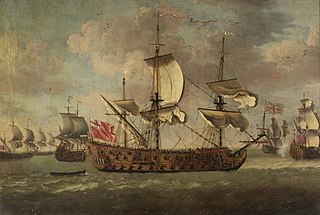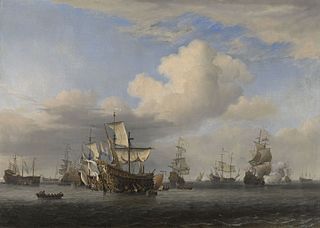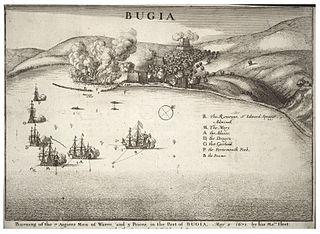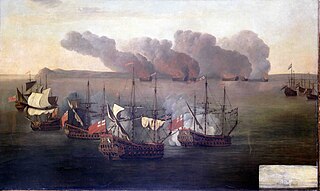
HMS Duke was a 90-gun second-rate ship of the line of the Royal Navy, launched on 13 June 1682 at Woolwich Dockyard.

HMS Falkland was a 50-gun fourth-rate ship of the line of the Royal Navy, built by Holland of New Castle, New Hampshire, and purchased by the navy in 1696.

HMS St Andrew was a 96-gun first-rate ship of the line of the Royal Navy, built by Christopher Pett at Woolwich Dockyard under the supervision of Christopher Pett until his death in March 1668, completed by Jonas Shish, and launched in 1670. Commanded by George Churchill, she took part in the 1692 victory over the French navy at Barfleur & La Hogue.

HMS Swiftsure was a 70-gun third-rate ship of the line of the Royal Navy, built by Sir Anthony Deane at Harwich, and launched in 1673. By 1685 she had been reduced to a 66-gun ship.

HMS Swiftsure was a 42-gun great ship of the English Royal Navy, built by Andrew Burrell at Deptford and launched in 1621.
HMS Dreadnought was a 52-gun third-rate ship of the line, in service with the Royal Navy from 1660 to 1690.

Newbury was a 52-gun third rate Speaker-class frigate built for the navy of the Commonwealth of England at Limehouse, and launched in 1654. She was named for the Parliamentarian victories at the two battles of Newbury.
Bridgewater was a 52-gun third rate Speaker-class frigate built for the navy of the Commonwealth of England at Deptford, and launched in 1654.
Lyme was a 52-gun third rate Speaker-class frigate built for the navy of the Commonwealth of England at Portsmouth, and launched in 1654.
Langport was a 50-gun third rate Speaker-class frigate built for the navy of the Commonwealth of England at Horsleydown, and launched in 1654.

The ship that became the first HMS Resolution was a 50-gun third-rate frigate built under the 1652 Programme for the navy of the Commonwealth of England by Sir Phineas Pett at Ratcliffe, and launched in 1654 under the name Tredagh.

President was a 38-gun fourth rate frigate of the Royal Navy, originally built for the navy of the Commonwealth of England by Peter Pett I at Deptford Dockyard, and launched in 1650.
The Nantwich was a 40-gun Fourth rate frigate of the English Royal Navy, originally built for the navy of the Commonwealth of England at Bristol by Francis Baylie, and launched in 1654.

HMS Jersey was a 40-gun fourth rate frigate of the English Navy, originally built for the navy of the Commonwealth of England at Maldon, and launched in 1654. By 1677 her armament had been increased to 48 guns.

The Maidstone was a 40-gun fourth-rate frigate of the English Royal Navy, originally built for the navy of the Commonwealth of England at Woodbridge, and launched in 1654.
The Taunton was a 40-gun fourth-rate frigate of the Royal Navy, originally built for the Royal Navy by William Castle at Rotherhithe, and launched in 1654.

HMS Dover was a 40-gun fourth-rate frigate of the Royal Navy, originally built for the navy of the Commonwealth of England at Shoreham by William Castle, and launched in 1654. By 1677, her armament had been increased to 48 guns.
HMS Albemarle was a 90-gun second rate ship of the line of the Royal Navy, launched on 29 October 1680 at Harwich.

HMS Humber was an 80-gun third rate ship of the line of the Royal Navy, launched at Hull on 30 March 1693.

HMS Canterbury was a 60-gun fourth-rate ship of the line of the Royal Navy, launched at Deptford on 18 December 1693.













